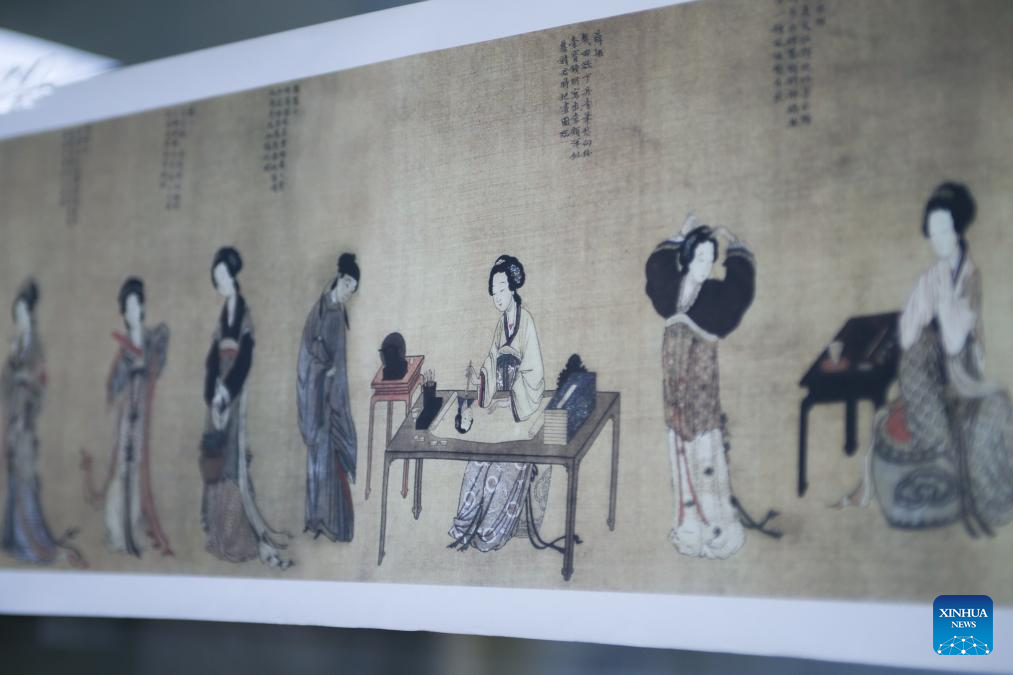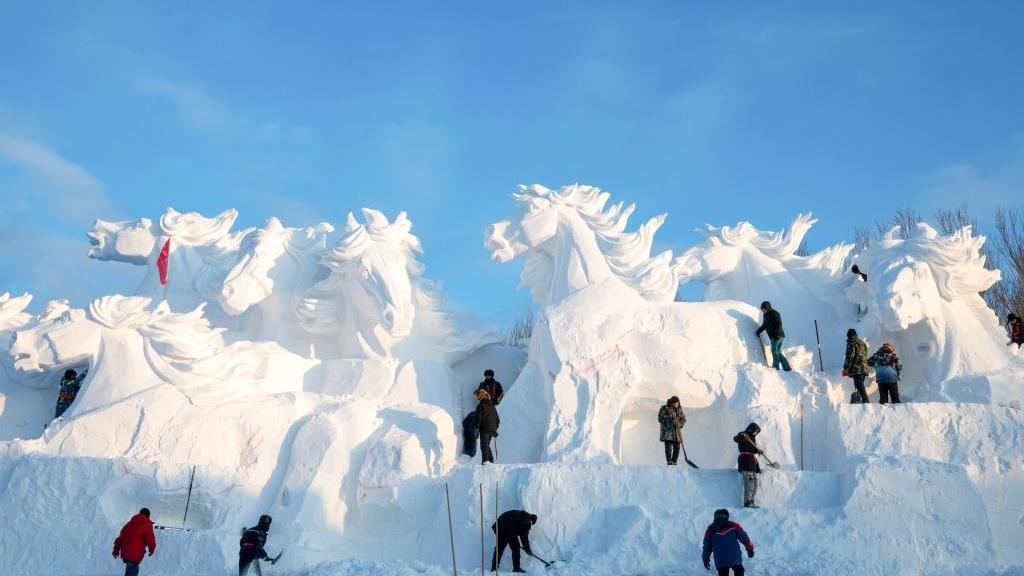Pic story of intangible cultural heritage inheritor of ivory carving in Beijing

This photo taken on Dec. 17, 2024 shows a picture for designing ivory carving artwork displayed at the studio of Li Chunke in Beijing, capital of China. (Xinhua/Zhu Weixi)
Ivory Carving, an ancient craft in China, was famous for its elegance due to its pure white material -- ivory. The earliest ivory carving artwork was found in a cultural relic in China during the Neolithic Age, dating back to 7,000 years ago. Beijing Ivory Carving, featuring elegant and luxuriant styles inherited from the imperial art, goes through several main procedures before completion such as designing, hewing, shoveling, face shaping and grinding.
China has been intensifying its efforts in wildlife protection over the years. On Dec. 30, 2016, China declared that it would enforce a complete end of its domestic ivory trade within a year. Starting from Dec. 31 of 2017, processing or selling ivory and its products has been officially banned in China. Nowadays, carvers use mammoth tusks or antlers as substitutes.
Li Chunke, born in 1949 in Beijing, a national-level intangible cultural heritage inheritor of ivory carving, started to learn the art since 15 years old. Over the sixty years of his career, Li has formed a uniquely simple and crisp style in his carving. He emphasizes on using the most simple lines and skills to express the theme of the artwork, also stressing on the traditional Chinese aesthetics. Many of his works have won important prizes in the art, with some be regarded as art treasures in China.
In recent years, Li passes down the craft at Chinese National Academy of Arts, Beijing Institute of Fashion Technology and Beijing Light Industry Polytechnic College. He has cultivated over 20 students with master's degrees in arts and crafts and over 100 apprentices on ivory carving. He has also presided over the maintaining and repairing projects on 100 plus ancient ivory carving artworks at the Beijing Arts & Crafts Museum. For him, the art should lay importance to its subtle beauty inherited from the traditional Chinese culture. To further develop it, China needs more young talents and should explore new carving materials.

Li Chunke stands in front of the displaying cabinet of his artworks at his studio in Beijing, capital of China, Dec. 17, 2024. (Xinhua/Zhu Weixi)

Li Chunke draws a design for ivory carving artwork at his studio in Beijing, capital of China, Dec. 17, 2024. (Xinhua/Zhu Weixi)

Apprentices of Li Chunke work at the studio of Li Chunke in Beijing, capital of China, Dec. 17, 2024. (Xinhua/Zhu Weixi)

This photo taken on Dec. 17, 2024 shows a mammoth tusk carving artwork made with micro-carving skills displayed at the studio of Li Chunke in Beijing, capital of China. (Xinhua/Zhu Weixi)

An apprentice of Li Chunke makes an antler carving artwork at Li Chunke's studio in Beijing, capital of China, Dec. 17, 2024. (Xinhua/Zhu Weixi)

This photo taken on Dec. 17, 2024 shows a mammoth tusk carving artwork displayed at the studio of Li Chunke in Beijing, capital of China. (Xinhua/Li Xin)

This photo taken on Dec. 17, 2024 shows a mammoth tusk carving artwork made with micro-carving skills displayed at the studio of Li Chunke in Beijing, capital of China. (Xinhua/Li Xin)

Li Chunke instructs his apprentice at his studio in Beijing, capital of China, Dec. 17, 2024. (Xinhua/Li Xin)

This photo taken on Dec. 17, 2024 shows a mammoth tusk carving artwork displayed at the studio of Li Chunke in Beijing, capital of China. (Xinhua/Zhu Weixi)

This photo taken on Dec. 17, 2024 shows a mammoth tusk carving artwork displayed at the studio of Li Chunke in Beijing, capital of China. (Xinhua/Zhu Weixi)

Li Chunke poses for a portrait at his studio in Beijing, capital of China, Dec. 17, 2024. (Xinhua/Zhu Weixi)

This photo taken on Dec. 17, 2024 shows a mammoth tusk carving artwork displayed at the studio of Li Chunke in Beijing, capital of China. (Xinhua/Zhu Weixi)

An apprentice of Li Chunke works at the studio of Li Chunke in Beijing, capital of China, Dec. 17, 2024. (Xinhua/Li Xin)

This photo taken on Dec. 17, 2024 shows a mammoth tusk carving artwork displayed at the studio of Li Chunke in Beijing, capital of China. (Xinhua/Zhu Weixi)

This photo taken on Dec. 17, 2024 shows a mammoth tusk carving artwork displayed at the studio of Li Chunke in Beijing, capital of China. (Xinhua/Li Xin)

This photo taken on Dec. 17, 2024 shows a mammoth tusk carving artwork displayed at the studio of Li Chunke in Beijing, capital of China. (Xinhua/Li Xin)

This photo taken on Dec. 17, 2024 shows a mammoth tusk carving artwork displayed at the studio of Li Chunke in Beijing, capital of China. (Xinhua/Li Xin)

Li Chunke poses for a portrait at his studio in Beijing, capital of China, Dec. 17, 2024. (Xinhua/Li Xin)

Li Chunke introduces a mammoth tusk carving artwork at his studio in Beijing, capital of China, Dec. 17, 2024. (Xinhua/Li Xin)

Li Chunke makes a mammoth tusk carving artwork at his studio in Beijing, capital of China, Dec. 17, 2024. (Xinhua/Li Xin)

Li Chunke makes a mammoth tusk carving artwork at his studio in Beijing, capital of China, Dec. 17, 2024. (Xinhua/Li Xin)

Li Chunke introduces a mammoth tusk carving artwork at his studio in Beijing, capital of China, Dec. 17, 2024. (Xinhua/Li Xin)

An apprentice of Li Chunke makes an antler carving artwork at Li Chunke's studio in Beijing, capital of China, Dec. 17, 2024. (Xinhua/Li Xin)
Photos
Related Stories
- China sees remarkable progress in keeping intangible cultural heritage alive
- Traditional art of Cangxian lion dance well passed on with local support
- Traditional Li textile techniques get all-round protection, development in Hainan province
- In pics: roofed arch bridges in Taishun County of China's Zhejiang
- Inheritor dedicated to passing on colored pottery craft in NW China's Gansu
Copyright © 2024 People's Daily Online. All Rights Reserved.









